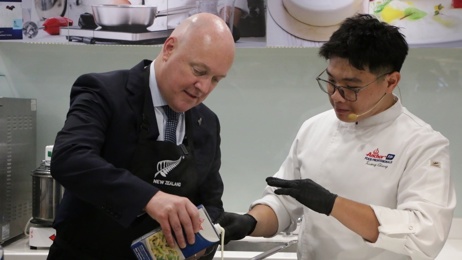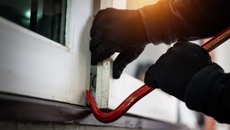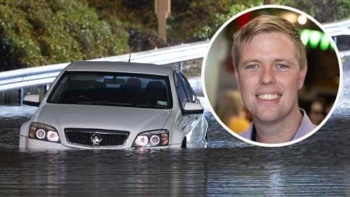In the rush to build homes in Auckland, are the authorities adequately equipped to monitor and oversee hundreds of building projects across the city?
There's concern a certain element within the building industry cuts corners when it comes to health and safety regulations. That small element is having quite a significant detrimental impact.
I'm right in the middle of it, with my home sandwiched between two building sites. The first project started a year ago. Since then, I've had my phone and internet cut, sewerage through my front door, my driveway cracked, garden ruined and fence damaged. My neighbours were inundated by un-contained runoff.
A council building compliance officer agreed that the damage to our driveway was most likely caused by next door - but I couldn't prove it, so I'd have to take legal action at my own cost.
The project stalled when the owners went back to China to live for four months, leaving behind a large concrete base with a more than three metre fall and no safety barriers in place. A to-and-fro debate continued with council about whether the drop off was a hazard. I was told the builders were acting within their resource consent. Eventually a safety barrier was erected.
But it gets worse.
On the other side, a site containing a large three-storey dwelling was being cleared. Then the digger came in. Nobody felt the need to let us know the demolition was happening. I rushed home just in time to witness the digger ripping apart the house.
I'm no building or safety expert, but I was immediately concerned about how the demolition was unfolding. There were no safety barriers to protect neighbouring properties. None of the men on the site had any safety gear. No hard hats, no high vis vests - nothing.
As I witnessed the building being clawed apart, I was stunned to watch the side of the house fall and smash over into my property. It's an area where my children play. Thank God, they were not home at the time. There was wood and glass everywhere. They hadn't removed the glass windows before demolition - an apparent requirement.
The digger stopped briefly as men came down to try and lift the wall from my property. One of them stood on top of my frail trellis fence. The digger started up again, continuing to demolish the property with them still in it.
I immediately called Auckland Council and WorkSafe. I also provided photographic and video evidence. The incident was marked urgent by the council. That was at 9.30 that morning. By 3.30pm, it was clear they weren't coming. By this point, the site had been fully cleared. I watched as the digger cleared up the rubble on land that had not been wet down. Dust and dirt billowed everywhere.
The compliance officer reviewed the site the next morning, saying there was "no hazard" to report. I could have told him that - the house and mess had been cleared. In the days that followed, I was told in a number of different ways what the council couldn't do to take action, rather than what it could.
The arguments given would require most people to have a specialist degree to understand them.
WorkSafe's response officer told me they only deal with "falls from heights and quad bike accidents" and referred me back to council. The response officer bristled when I quoted WorkSafe's own regulations from its website. He eventually agreed to investigate if I could provide him with company names - individual names and numbers were not enough. If he could find a history of previous offending - then he'd investigate. It took me three days to locate and provide the company names. That was where my personal communication with him ended.
Over the following week, I spent hours trying to get help, but the council compliance officer said he couldn't do anything. It was also suggested to me on more than one occasion that maybe my issue is more one of being anti progress.
A week after the demolition, men in orange suits and face masks arrived next door. They were testing for asbestos. They'd been contracted by the owner following the discovery of asbestos. Two weeks after being notified of the demolition, Auckland Council and WorkSafe got involved. I was informed my property and others may also have been contaminated . This is the same demolition that Auckland Council and WorkSafe deemed not to be a hazard.
We'd spent an entire week with our children playing outside. The stress we faced over this time was enormous. We were advised to keep the family inside. Surrounding neighbours were incredibly distressed. One of them is just recovering from breast cancer.
It took just under a week to have tests confirm that we were clear of asbestos contamination. The asbestos was contained to the offending site. Auckland Council and WorkSafe are now involved in the clean up next door - but the damage is done. We're exhausted, traumatised and extremely frustrated.
Are my neighbours the only ones in Auckland who are facing this struggle to get action from the council over valid complaints? Unlikely.
Many of us don't have the time, the nouse, or the energy to battle such officials who appear under resourced or completely disinterested. On interviewing Auckland Council's general manager of building, he was shocked that the site hadn't been shut down immediately. It's sparked the council to look at re-educating its council compliance officers.
WorkSafe's project manager for construction was also surprised no action had been taken sooner. There appears to be a disconnect between what is expected and what is reality.
The Certified Builders Association agrees there is a certain element within the building industry who are cutting out health and safety in favour of cheaper builds. It's also been acknowledged by WorkSafe and the CBA that some foreign builders are also problematic. Language barriers and cultural differences are an issue.
WorkSafe is working closely with the Chinese Real Estate Association of New Zealand to improve education. Maybe it's time the council reassesses its policies and procedures when it comes to building complaints. There is a need to better protect those of us who face risk to our properties and safety, through no fault of our own.
We as rate payers have a voice, and it deserves to be heard.
Take your Radio, Podcasts and Music with you









